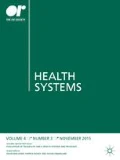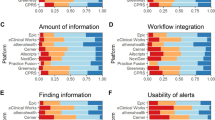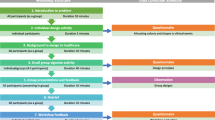Abstract
Objective: It is essential to design technologies and systems that promote appropriate interactions between physicians and patients. This study explored how physicians interact with Electronic Health Records (EHRs) to understand the qualities of the interaction between the physician and the EHR that may contribute to positive physician–patient interactions. Study Design: Video-taped observations of 100 medical consultations were used to evaluate interaction patterns between physicians and EHRs. Quantified observational methods were used to contribute to ecological validity. Methods: Ten primary care physicians and 100 patients from five clinics participated in the study. Clinical encounters were recorded with video cameras and coded using a validated coding methodology in order to examine how physicians interact with EHRs. Results: Three distinct styles were identified that characterize physician interactions with the EHR: technology-centered, human-centered, and mixed. Physicians who used a technology-centered style spent more time typing and gazing at the computer during the visit. Physicians who used a mixed style shifted their attention and body language between their patients and the technology throughout the visit. Physicians who used the human-centered style spent the least amount of time typing and focused more on the patient. Conclusion: A variety of EHR interaction styles may be effective in facilitating patient-centered care. However, potential drawbacks of each style exist and are discussed. Future research on this topic and design strategies for effective health information technology in primary care are also discussed.


Similar content being viewed by others
References
Bakeman R (2000) Behavioral observation and coding. Handbook of Research Methods in Social and Personality Psychology (REIS HT and JUDD CM, Eds), pp138–159, Cambridge University Press, Cambridge, UK.
Blumenthal D (2009) Stimulating the adoption of health information technology. New England Journal of Medicine 360 (15), 1477–1479.
Boyatzis RE (1998) Transforming Qualitative Information: Thematic Analysis and Code Development. Sage Publications, California.
Chaudhry B et al (2006) Systematic review: impact of health information technology on quality, efficiency, and costs of medical care. Annals of Internal Medicine 144 (10), e12–e22.
Fang H, Peifer K, Chen J and Rizzo J (2011) Health information technology and physicians’ perceptions of healthcare quality. The American Journal of Managed Care 17 (3), e66–e70.
Goldberg D and Richardson C (1993) Touch-typing with a stylus. Paper presented at the INTERACT ‘93 and CHI ‘93 conference on Human factors in computing systems, New York.
Graham-Jones P, Jain SH, Friedman CP, Marcotte L and Blumenthal D (2012) The need to incorporate health information technology into physicians’ education and professional development. The need to incorporate health information technology into physicians’ education and professional development. Health Affairs 31 (3), 481–487.
Hall MA et al (2002) Measuring patients’ trust in their primary care providers. Medical Care Research and Review 59 (3), 293–318.
Hayrinen K, Saranto K and Nykanen P (2007) Definition, structure, content, use and impact of electronic health records: a review of the research literature. International Journal of Medical Informatics 77 (5), 291–304.
Holden RJ (2011) Social and personal normative influences on healthcare professionals to use information technology: towards a more robust social ergonomics. Theoretical Issues in Ergonomics Science 13 (5), 1–24.
Lawler EK, Hedge A and Pavlovic-Veselinovic S (2011) Cognitive ergonomics, socio-technical systems, and the impact of healthcare information technologies. International Journal of Industrial Ergonomics 41 (4), 336–344.
Lelievre S and Schultz K (2010) Does computer use in patient-physician encounters influence patient satisfaction? Canadian Family Physician 56 (1), e6–e9.
Lown BA and Rodriguez D (2012) Commentary: lost in translation? How electronic health records structure communication, relationships, and meaning. Academic Medicine 87 (4), 392–394.
Marcinowicz L, Konstantynowicz J and Godlewski C (2010) Patients’ perceptions of GP non-verbal communication: a qualitative study. The British Journal of General Practice 60 (571), 83–87.
Margalit RS, Roter D, Dunevant MA, Larson S and Reis S (2006) Electronic medical record use and physician-patient communication: an observational study of Israeli primary care encounters. Patient Education and Counseling 61 (1), 134–141.
Miles MB and Hubberman AM (1994) Data management and analysis methods. In Qualitative Data Analysis: An Expanded Sourcebook (DENZIN NK and LINCOLN YS, Eds), 2nd edn, pp 428–444, Sage Publication, Thousand Oaks, CA.
Montague E and Asan O (2012) Trust in technology-mediated collaborative health encounters: constructing trust in passive user interactions with technologies. Ergonomics 55 (7), 725–761.
Montague E, Winchester WW and Kleiner BM (2010) Trust in medical technology by patients and health care providers in obstetric work systems. Behaviour & Information Technology 29 (5), 541–554.
Montague E, Xu J, Chen P, Asan O, Barrett BP and Chewning B (2011) Modeling eye gaze patterns in clinician – patient interaction with lag sequential analysis. Human Factors: The Journal of the Human Factors and Ergonomics Society 53 (5), 502–516.
Morrow JB, Dobbie AE, Jenkins C, Long R, Mihalic A and Wagner J (2009) First-year medical students can demonstrate EHR-specific communication skills: a control-group study. Family Medicine 41 (1), 28–33.
Ong L, De Haes J, Hoos A and Lammes F (1995) Doctor-patient communication: a review of the literature. Social Science & Medicine 40 (7), 903–918.
Otto A, Kushniruk A, Ho K, Joe R and Borycki E (2009) Incorporation of medical informatics and information technology as core components of undergraduate medical education-Time to change. Studies in Health Technology and Informatics 143 (1), 62–67.
Pearce C, Arnold M, Phillips C, Trumble S and Dwan K (2011) The patient and the computer in the primary care consultation. Journal of the American Medical Informatics Association 18 (2), 138–142.
Pearson SD and Raeke LH (2000) Patients’ trust in physicians: many theories, few measures, and little data. Journal of General Intern Medicine 15 (7), 509–513.
Rao SR, DesRoches CM, Donelan K, Campbell EG, Miralles PD and Jha AK (2011) Electronic health records in small physician practices: availability, use, and perceived benefits. Journal of the American Medical Informatics Association 18 (3), 271–275.
Rippen HE, Pan EC, Russell C, Byrne CM and Swift EK (2012) Organizational framework for health information technology. International Journal of Medical Informatics, in press, available online 28 February 2012.
Roter D, Frankel R, Hall J and Sluyter D (2006) The expression of emotion through nonverbal behavior in medical visits. Journal of General Internal Medicine 21 (S1), S28–S34.
Rouf E, Whittle J, Lu N and Schwartz MD (2007) Computers in the exam room: differences in physician – patient interaction may be due to physician experience. Journal of General Internal Medicine 22 (1), 43–48.
Shachak A and Reis S (2009) The impact of electronic medical records on patient – doctor communication during consultation: a narrative literature review. Journal of Evaluation in Clinical Practice 15 (4), 641–649.
Singh R, Lichter MI, Danzo A, Taylor J and Rosenthal T (2012) The adoption and use of health information health information technology in rural areas: results of a national survey. The Journal of Rural Health 28 (1), 16–27.
Stead WW and Lin H (2009) Computational Technology for Effective Health Care: Immediate Steps and Strategic Directions. National Academy Press, Washington, DC.
Sykes TA, Venkatesh V and Rai A (2011) Explaining physicians’ use of EMR systems and performance in the shakedown phase. Journal of the American Medical Informatics Association 18 (2), 125–130.
Thom DH, Kravitz RL, Bell RA, Krupat E and Rahman A (2002) Patient trust in the physician: relationship to patient requests. Family Practice 19 (5), 476–483.
Ventres W, Kooienga S, Marlin R, Vuckovic N and Stewart V (2005) Clinician style and examination room computers: a video ethnography. Family Medicine 37 (4), 276–281.
Ventres W and Shah A (2007) How do EHRs affect the physician-patient relationship? American Family Physicians 75 (9), 1389–1391.
Acknowledgements
The University of Wisconsin–Madison Systems Engineering Initiative for Patient Safety (SEIPS) and the Wisconsin Research and Education Network (WREN) provided support on this project. We thank undergraduate research assistants who assisted with data analysis and graduate research assistants who assisted with data collection.
Funding Source: This publication was supported by Grant No. 1UL1RR025011 from the Clinical & Translational Science Award (CTSA) program of the National Center for Research Resources of the National Institutes of Health.
Ethics approval: This study was conducted with the approval of the University of Wisconsin-Madison Health Science Institutional Review Board.
Author information
Authors and Affiliations
Corresponding author
Ethics declarations
None of the authors have any conflicts of interest that could bias this work.
Rights and permissions
About this article
Cite this article
Asan, O., Montague, E. Physician interactions with electronic health records in primary care. Health Syst 1, 96–103 (2012). https://doi.org/10.1057/hs.2012.11
Received:
Revised:
Accepted:
Published:
Issue Date:
DOI: https://doi.org/10.1057/hs.2012.11




